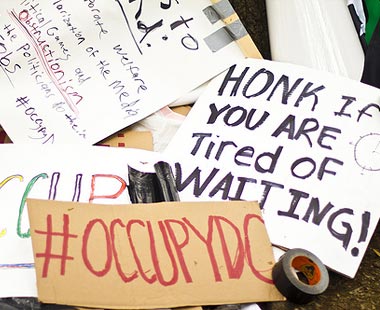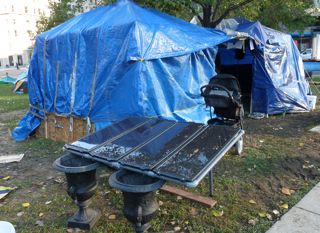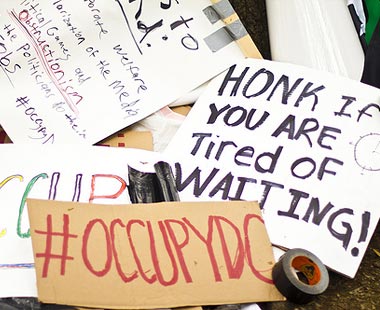 Photo: thisisbossiIt’s 8:30 Thursday morning in McPherson Square, just a few streets up from the north lawn of the White House, and somehow I’ve been duped into carrying a foldable cot over to a yellow medical tent. Such are the risks of reporting on a movement that depends heavily on people power.
Photo: thisisbossiIt’s 8:30 Thursday morning in McPherson Square, just a few streets up from the north lawn of the White House, and somehow I’ve been duped into carrying a foldable cot over to a yellow medical tent. Such are the risks of reporting on a movement that depends heavily on people power.
“Do you know anything about the solar panels?” I ask a group of about 15 Occupy D.C. protestors who are holding the day’s first “general assembly” outside the tent.
“I don’t know anything about solar panels,” replies a woman with muddy pants and a head bandanna. “But if you could help us carry some boxes, I can get someone who might know.”
We maneuver deeper into the encampment, past a makeshift mess hall, guys with long, gray beards in sleeping bags on the concrete walkways, and rows of multi-colored Coleman tents. Signs shouting “Occupy D.C.!” and “People are a good investment!” are strewn about.
 The solar panels and media tent.Photo: Andrew ZaleskiEventually, the woman directs me toward the media tent, constructed from sheets of plywood and blue tarps held up by poles and cut in the center by a tree. Just outside, a small array of four solar panels is propped up on an adjustable rack and two black plant potters. It’s a small statement of independence from the energy giants amid a chaotic many-voiced movement.
The solar panels and media tent.Photo: Andrew ZaleskiEventually, the woman directs me toward the media tent, constructed from sheets of plywood and blue tarps held up by poles and cut in the center by a tree. Just outside, a small array of four solar panels is propped up on an adjustable rack and two black plant potters. It’s a small statement of independence from the energy giants amid a chaotic many-voiced movement.
The idea to bring sun power to Occupy D.C. was hatched by Glenn Hurowitz, a senior fellow at the Center for International Policy, where he does writing and advocacy work on environment and climate issues. (Hurowitz is a longtime contributor to Grist.) “I saw a story in the New York Times that mentioned [Occupy Wall Street] was running on gas generators,” Hurowitz says. “It didn’t seem right that a movement that’s supposed to change the world should be propping up big oil.”
So when Hurowitz ran into Greenpeace Director Phil Radford at a whiskey tasting in Virginia, he suggested that the group send the Rolling Sunlight — a biodiesel-fueled truck kitted out with 256 square-feet of photovoltaic cells — up to the New York City protests. Then Hurowitz pitched a similar idea to the protestors at Occupy D.C.
To raise the $1,375 to purchase the panels, Hurowitz set up a fundraising campaign on WePay, and donations came in from a slew of individual donors. Last Friday night, the general assembly agreed to donate an additional $250 if costs warranted it. The panels were ordered off of Amazon and delivered Tuesday to McPherson Square, where they were set up on Wednesday.
When I arrive at the media tent Thursday morning, though, the only one on the scene who knows anything about the solar panels is Kelly Mears, a 24-year-old software developer who quit his job to join the protest movement. (Come the evening, he assures me, more occupiers who worked to acquire the solar panels will be on hand.) Mears, who has camped in McPherson Square for 20 days, says he handles “all of the tech stuff here.”
“The true Occupiers are very, very excited about this,” he says, with a nod to the panels.
 Mears’ contraption.Photo: Andrew ZaleskiThe photovoltaic system itself is 120 watts, and it’s used to charge an external battery that is then hooked up to an inverter, into which electronic gadgets can be plugged. When charged, Mears estimates that the battery can “probably run a few laptops for about 12 hours.” He shows me a contraption he has rigged with a baby stroller that will allow him to take his computer (perched on the shade canopy) and a battery (where the baby would usually sit) along on marches so he can do a live stream online.
Mears’ contraption.Photo: Andrew ZaleskiThe photovoltaic system itself is 120 watts, and it’s used to charge an external battery that is then hooked up to an inverter, into which electronic gadgets can be plugged. When charged, Mears estimates that the battery can “probably run a few laptops for about 12 hours.” He shows me a contraption he has rigged with a baby stroller that will allow him to take his computer (perched on the shade canopy) and a battery (where the baby would usually sit) along on marches so he can do a live stream online.
The trouble is, the tech crew is missing an adapter necessary for connecting the panels to the battery. So they’re charging the battery with their gas-powered generator instead. “Right now, we’re not using the output in the smartest way,” Mears says.
Nick Bryner, a 27-year-old, fourth-year law student at George Washington University who assisted with the solar panel installation, says that even when the solar array is connected, “It’s not going to be enough to cover all the energy needs.” But that, he argues, is the lesson of solar energy. “It’s a transition, but it’s something we need to start building in more.”
Other Occupy locations have turned to solar energy as a means of powering their protests. Occupy Boston has devised a solar-charging USB box to keep cell phones juiced up. The Rolling Sunlight did make it to Wall Street, where it powered the media center there. But three days in, it had to be driven back to D.C. for repairs, according to Greenpeace media officer Molly Dorozenski. There was apparently some sort of charging problem with the batteries.
Hurowitz says there are natural overlaps between the protests and environmental issues. “Nobody is a better symbol of … corporate greed and corruption than the oil and coal industries,” he says. “For a lot of people in the Occupy movement, part of creating a better world is making sure we have a living planet.”
Of course, Hurowitz isn’t the first to make the case that the green movement is a logical addition to the nationwide Occupy movement. Environmental writer and activist Bill McKibben, co-founder of 350.org (and Grist board member), stated defiantly at Occupy Wall Street, “The reason that it’s so great that we’re occupying Wall Street is because Wall Street has been occupying the atmosphere.”
But for now, at least, environmental concerns don’t seem to be bubbling to the surface of a movement that’s largely fueled by economic woes — and populated by a wide range of individuals who bring their own agendas and ideas to the encampment.
“Fuck the system!” yells an occupier with a New York Jets hoodie, Dickies pants, and a black head bandanna, walking over to the media tent, where I’m talking to Mears. I’m about to ask the newcomer about the solar panels positioned directly behind him when he launches into a diatribe about corrupt cops, crooked bankers, and how “nonviolence only goes so fucking far.”
Mears casts me a sideways glance. “It’s never going to be a utopia.”


